Empirical Insights into Salvage Wood Logistics
doi: 10.5552/crojfe.2024.2272
volume: 45, issue: 2
pp: 17
- Author(s):
-
- Kogler Christoph
- Beiglböck Alexander
- Rauch Peter
- Article category:
- Original scientific paper
- Keywords:
- resilient wood supply chain management, wood transport, wood storage, insect and fungal infestations, wind storms, risk management, contingency planning, coping strategies, empirical online survey
Abstract
HTML
Climate crises and natural disasters increasingly challenge wood supply chains by the critical need to transport high volumes of salvage wood quickly out of the forests to limit wood value loss and to prevent inducing forest calamities. Salvage wood logistics covering unimodal, multimodal and multi-echelon unimodal transport as well as storage plays an essential role in tackling existing problems and future risks by linking diverse actors along wood supply chains. Since little is known about specific challenges in salvage wood logistics, an extensive empirical study was conducted to evaluate logistics concepts and coping strategies involving stakeholders representing the entire wood value chain in Austria. The knowledge and experience of 161 forest owners, transport operators and wood-based industry actors were surveyed based on questionnaires with 108 matrix, rating, Likert scale and open questions. Results show a significant loss in salvage wood transport capacity due to long waiting times at receiving mills leading to more than one-fourth lost transport capacity in the unimodal salvage wood supply chain. Sustainable and resilient wood supply chain management can be achieved by increasing train and semitrailer truck wood transport as well as wood storage capacity and by improving both working conditions for self-loading log-truck drivers and cooperation between stakeholders.
Empirical Insights into Salvage Wood Logistics
Christoph Kogler, Alexander Beiglböck, Peter Rauch
Abstract
Climate crises and natural disasters increasingly challenge wood supply chains by the critical need to transport high volumes of salvage wood quickly out of the forests to limit wood value loss and to prevent inducing forest calamities. Salvage wood logistics covering unimodal, multimodal and multi-echelon unimodal transport as well as storage plays an essential role in tackling existing problems and future risks by linking diverse actors along wood supply chains. Since little is known about specific challenges in salvage wood logistics, an extensive empirical study was conducted to evaluate logistics concepts and coping strategies involving stakeholders representing the entire wood value chain in Austria. The knowledge and experience of 161 forest owners, transport operators and wood-based industry actors were surveyed based on questionnaires with 108 matrix, rating, Likert scale and open questions. Results show a significant loss in salvage wood transport capacity due to long waiting times at receiving mills leading to more than one-fourth lost transport capacity in the unimodal salvage wood supply chain. Sustainable and resilient wood supply chain management can be achieved by increasing train and semitrailer truck wood transport as well as wood storage capacity and by improving both working conditions for self-loading log-truck drivers and cooperation between stakeholders.
Keywords: resilient wood supply chain management, wood transport, wood storage, insect and fungal infestations, wind storms, risk management, contingency planning, coping strategies, empirical online survey
1. Introduction
Sustainable, green and resilient wood value chains play a crucial role in providing green jobs (FAO 2020) and achieving the sustainable development goals (FAO 2018) to limit climate change (FAO 2022). The importance of forests and wood value chains can be appreciated when considering that 31% of the total land area is covered with forests globally (FAO 2020). Within the European Union, the forest cover is higher with 45% (Eurostat 2020) and even higher in Austria with 48% (AFRW 2023).
Forest ecosystems suffer heavily under the climate crises and increasingly frequent natural disasters, which lead to high amounts of salvage wood, together with outdated forest management practices and a critical age structure of the forests. This in turn pushes previously applied decision-making tools as well as transport and storage planning instruments of the wood supply chain to their limits. Salvage wood arises due to abiotic (e.g., storms, fire, drought, snow/ice break, hail, frost) or biotic (mainly insect and fungal infestations) factors. Environmental influences, such as climate change, lead to an increasing number of abiotic forest calamities, such as storms, frequently followed by biotic damages through bark beetle infestations leading to wood value loss (Kogler and Rauch 2023).
For example, in 2019 there were high salvage wood amounts in Central Europe, such as 91% of the entire wood harvest in the Czech Republic, 86% in Germany, 36% in Slovakia and 19% in Switzerland (Ebner 2020). Austria also suffered heavily from high salvage wood amounts during the last decades (Fig. 1). In the three reported years - 2018, 2019 and 2020, the already high 30-year average of 35% salvage wood was substantially exceeded with the share of 54%, 62% and 54%, respectively.
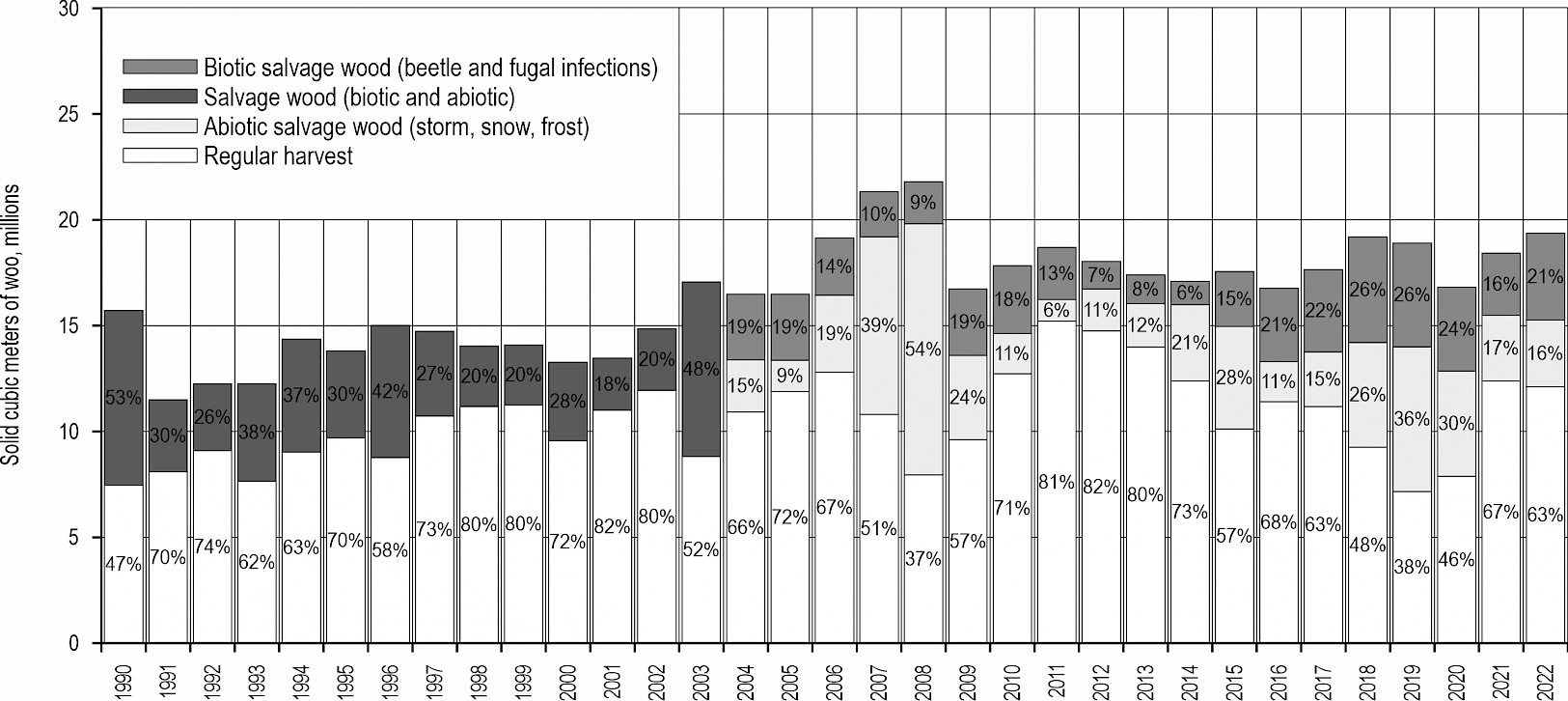
Fig. 1 Regular harvest and salvage wood amounts in Austria from 1990 until 2022 with a distinction between biotic and abiotic salvage wood since 2004 (AFRW 1990–2022)
For actors along the wood value chain, this implies an increasing need to assess risks, evaluate long-term risk consequences and derive strategic, tactical, and operational measures to ensure a resilient wood supply (Kogler 2023). Existing control mechanisms fail in the face of short-term changes, emergence of risks and in the event of a forest calamity. Managers have neither time nor appropriate methodological support to holistically evaluate different strategy options and develop robust measures (Kogler and Rauch 2020a). In addition to forest calamity events, supply chain risks, such as lack of transport capacity, planning problems or technical risks lead to long delivery and waiting times of trucks in industrial facilities and, thus, represent novel, critical and complex logistics challenges (Kogler 2020).
Previous studies of transportation in wood supply chains were conducted focusing on quantitative simulation (Kogler and Rauch 2018) and optimization approaches (Acuna 2017). For Austria, those include discrete event simulation studies of multimodal transport, where wood is transhipped from self-loading log-trucks to trains (Kogler and Rauch 2019, Kogler and Rauch 2023), as well as multi-echelon unimodal transport, where wood is transhipped from self-loading log-trucks to semitrailer trucks (Kogler et al. 2020) and optimization approaches (Hirsch and Gronalt 2013, Kogler 2016, Kogler et al. 2021). Scientific models were also applied in practice for contingency planning (Kogler and Rauch 2020a) and game-based workshops for knowledge transfer (Kogler and Rauch 2020b). Relevant simulation as well as optimization models have also been developed for other leading countries of the wood-based industry such as Australia (Acuna et al. 2019), Canada, Norway and Chile (D'Amours 2008) as well as Finland and Sweden (Väätäinen 2020). Further qualitative methodical approaches include analyses of strengths, weaknesses, opportunities and threats (SWOT) to formulate strategies (Rauch 2007, Rauch et al. 2015) and scenarios (Hynynen et al. 2015).
Empirical studies of the wood value chain examining wood supply chain phenomena, rationale of decisions and delivering formal and verifiable knowledge are very rare. Although empirical surveys are well established to study supply chains in other industries (e.g., food, cars, electronics), empirical research reports and articles about the wood value chain only deal with limited thematic aspects, restricted regions and selected stakeholder groups. The reason for such a small number of empirical surveys lies in the fact that they are time consuming and costly, and that it is difficult to achieve a sufficient number of responses on sensitive topics. Consequently, there is a research gap in empirical studies focusing on salvage wood logistics, transport, storage and strategy development as shown in Table 1.
Table 1 Empirical studies of wood value chain covering the topics of transport, storage, strategy development and salvage wood
|
Authors |
Year |
Country |
Participants |
Publication |
Transport |
Storage |
Strategy development |
Salvage wood |
|
Palander et al. |
2012 |
Finland |
76 |
Croatian Journal of Forest Engineering |
X |
– |
X |
– |
|
Malinen et al. |
2014 |
Finland |
86 |
Croatian Journal of Forest Engineering |
X |
– |
X |
– |
|
Freise et al. |
2015 |
Germany |
139 |
Project report |
X |
– |
– |
– |
|
Becker |
2019 |
Germany |
34 |
Thesis |
X |
– |
X |
– |
|
Gößwein et al. |
2019 |
Germany |
97 |
Project report |
X |
– |
X |
– |
|
AGR and DeSH |
2020 |
Germany |
58 |
Industry sector report |
– |
X |
– |
X |
|
Hedeler et al. |
2020 |
Austria |
89 |
Forest Policy and Economics |
– |
– |
X |
– |
|
Kogler et al. |
2024 |
Austria |
161 |
Croatian Journal of Forest Engineering |
X |
X |
X |
X |
This study provides for the first time a complete picture of salvage wood logistics describing the status quo in wood transport (e.g., transport mode selection, challenges, use of wood terminals) and wood storage (e.g., stockyard types, challenges, utilization) in Austria. In addition, it evaluates the current logistical concepts in use to identify strategic development potential and formulate coping strategies.
2. Materials and Methods
Empirical surveys provide a broad basis for further quantitative (e.g., simulation and optimization) and qualitative (e.g., SWOT-analyses, in-depth expert interviews) research approaches, improve the general understanding of a specific supply chain and fit well to derive recommendations, guidelines or policies. Therefore, empirical data on salvage wood transport and storage in Austria was surveyed anonymously with an online tool (i.e., LimeSurvey) based on four customized questionnaires for forestry, industry, transport and other stakeholder groups to address relevant topics and incorporate existing expert knowledge of different actors. From October to December 2020, the structure and contents of questionnaires were developed based on a comprehensive literature research including books, papers, conference proceedings, industry reports, project reports and theses as well as existing expert knowledge of the three cooperating researchers regarding wood supply chains. Several revision phases and three rounds of pretests involving statistics and marketing survey experts as well as ten wood supply scientists and ten industry experts led to the final formulation of 108 questions. Questions were grouped thematically with a focus on logistical concepts, transport and storage. The question types represent a mixture of numerical entries (39), matrix (25), single choice (15) and multiple-choice questions (8) for quantitative analyses as well as open questions (21) for qualitative analysis. This structure ensured a wide and diverse range of possible responses on the given topic to exploratorily discover (new) phenomena on the one hand, but also to cover comparable results based on standardized data collection and statistical analysis on the other hand. For the matrix questions, a four-point Likert scale with the choices »strongly agree«, »rather agree«, »rather disagree«, »strongly disagree« or »very high«, »rather high«, »rather low«, »very low« was applied. The described study design is summarized in Fig 2.
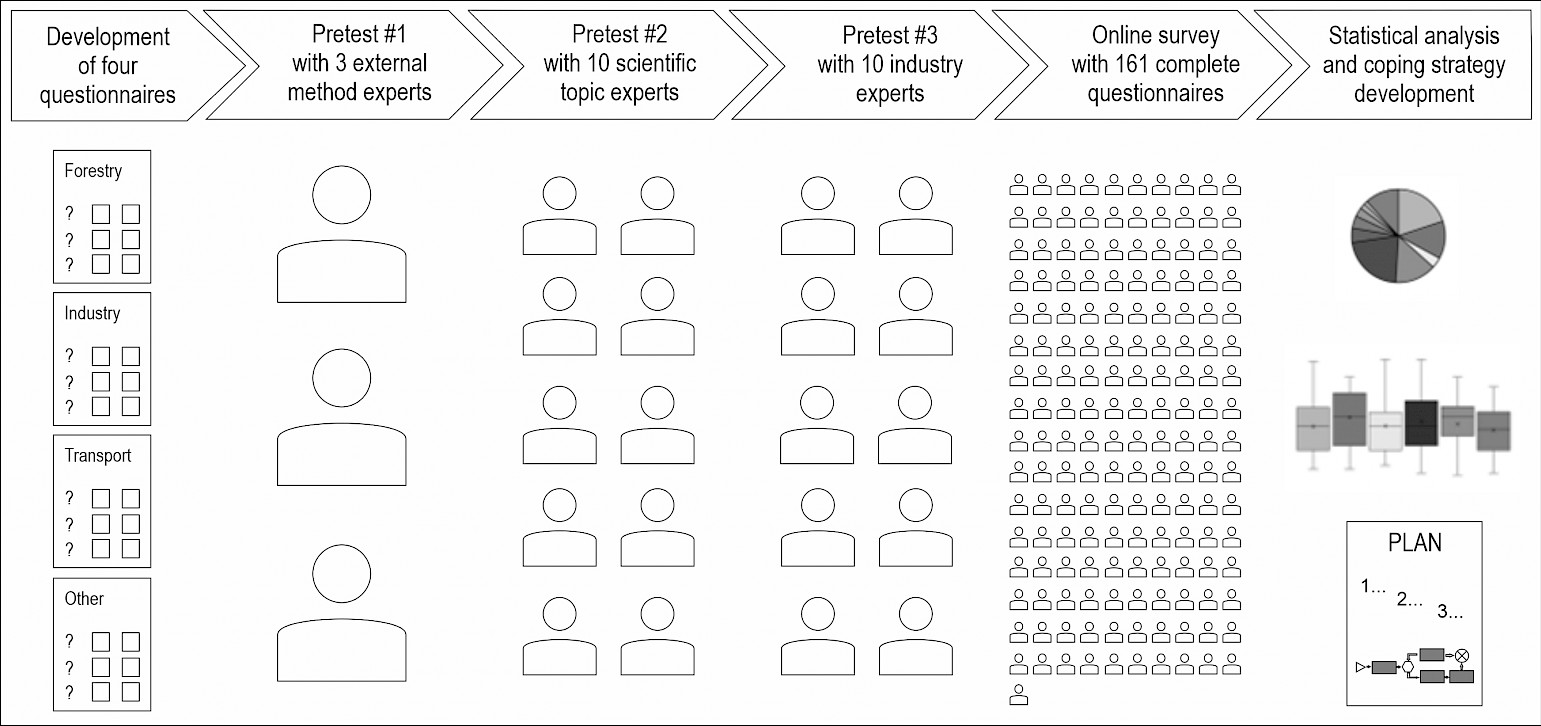
Fig. 2 Study design with questionnaire development, three rounds of pretests, online survey, statistical analysis and coping strategy development
Feedback from three pretests ensured clarity and comprehensibility of the questions and extensive test runs guaranteed a flawless online implementation of the survey. As a result, no technical or other kind of problem was reported during the three-month survey period from the beginning of January 2021 until the end of March 2021. Actors from the Austrian wood supply chain with expert knowledge on salvage wood logistics were defined as the target group and encouraged to participate in the online survey with industry-wide announcements. This included announcements in important magazines for the wood-based industry (i.e., »Holzkurier« with 16,000 gross weekly reach in print and 35,000 online) and forestry (i.e., »Forstzeitung« with 14,000 gross monthly reach) as well as newsletters of graduate associations (i.e., Austrian Wood Workers Association), official interest groups (i.e., Austrian Wood Industry Association, Austrian Paper Industry Association, Austrian Wood Owner Association) and industry cooperation platforms (i.e., Wood-Forestry-Paper). Furthermore, experts of the Austrian Federal Forests, forest owners, freight companies and industry actors were informed directly via the network of the Institute of Production and Logistics as well as of the Austrian Ministry of Agriculture, Regions and Tourism personally in project meetings, by phone or email. This approach led to the large number of 161 valid responses to be included in the qualitative and quantitative analyses, which exceeds comparable studies in Austria, Finland and Germany (see Table 1) both in scope (number of valid responses) and level of detail (number of questions).
After closing the online-survey, collected data of valid responses was exported to SPSS 26. In order to test if there were statistically significant differences between the estimates of surveyed stakeholder groups regarding the waiting time during the transhipment/unloading processes of roundwood, an analysis of variance was performed. Determining the distribution of the variables was considered important to choose an appropriate statistical method for the relatively small sample size. The result of a Shapiro-Wilk test with a set significance level α=0.05 showed that the data significantly deviates (p<0.001) from a normal distribution and therefore violates an ANOVA assumption (normality of residuals). Based on this outcome, the non-parametric Kruskal-Wallis H test (α=0.05) was conducted. The following null hypothesis was formulated: »the estimated waiting time for self-loading log-trucks is equal for all three stakeholder groups« (H0: µ1=µ2=µ3=µ), as well as the alternative hypothesis »the estimated waiting time for self-loading log-trucks differs for at least two stakeholder groups« (HA: ∃i,j µi≠µj),. To further expand the statistical analysis, an executed pairwise post-hoc test (Dunn´s test) revealed which groups differ from each other (see section 3.3, Fig. 11).
Valid response data set was condensed into tables, boxplots, network, pie, column, and (stacked) bar charts. The most relevant tables and figures for salvage wood logistics as well as statistical hypothesis tests regarding the critical factor of waiting times for different transport modes were carefully selected to be presented and interpreted in connection with qualitative answers to identify strategic development potential and formulate coping strategies. Within the graphs, attention was paid on consistent coloring of the actors (i.e., gray: forestry, white: transport, black: industry) as well as Likert scale (i.e. dark gray: very high/strongly agree, gray: rather agree/rather high, light gray: rather disagree/rather low, white: strongly disagree/very low) and reference was made by specifying the respective sample sizes (n-value). The presentation of the results follows the study design and is therefore grouped around study participants, logistical concepts, transport and storage.
3. Results
3.1 Study Participants
The well-balanced ratio of industry and forestry, representative amounts of large- (i.e., more than 200 hectares) and small- scale (i.e., less than 200 hectares) forest owners as well as plausible shares of actors heavily represented (i.e., sawmills) as well as minorly involved (i.e., authorities) in the Austrian wood supply chain is shown in Fig. 3. Furthermore, the statistics of the participants' experience (lower quartile: 15 years, higher quartile: 35 years) illustrates a sound expert knowledge represented by the participants with on average 25 years (median 26 years) of industry-specific experience (Fig. 4).
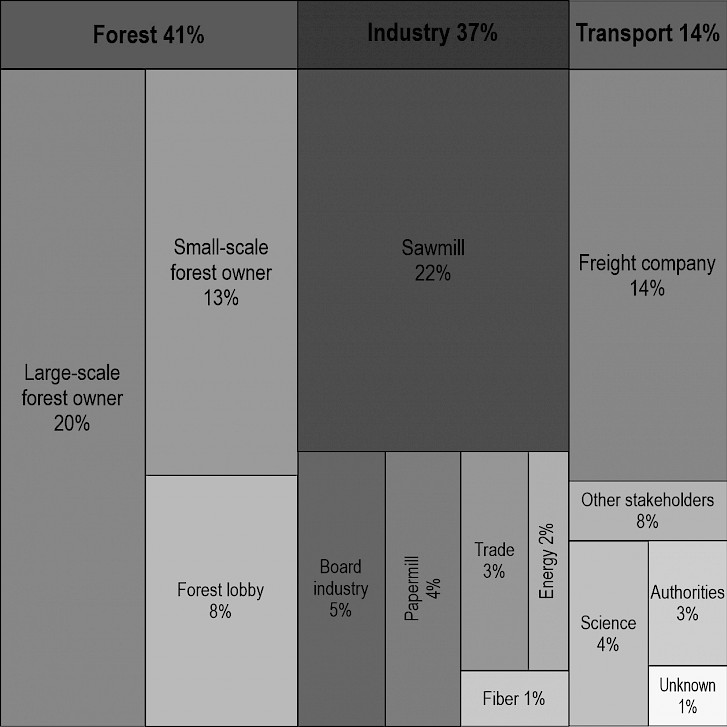
Fig. 3 Grouped activity fields of surveyed stakeholders (n=161)

Fig. 4 Industry experience distribution (median labeling) of surveyed stakeholder groups
3.2 Logistical Concepts
The empirical analysis explored strategies used by forestry, transport and industry actors to cope with high salvage wood amounts. Table 2 highlights the importance of long-term cooperation and contracts to establish planning reliability, which is especially valued by forestry (69%) and industry (48%). Furthermore, stockyards play a crucial role, especially for forestry actors, which frequently utilize dry (51%) as well as wet (31%) stockyards. Transport actors mainly focused on dry stockyards (36%), whereas industry relied on wet stockyards (30%). Foil stockyards (i.e., roundwood wrapped in a hermetically plastic film) maintaining wood quality under anerobic conditions were only used in a few cases (6%) by forestry and industry. Hiring staff was the preferred coping strategy of transport actors (45%), whereas industry and forestry focused on training the existing staff (33%). Investments in self-loading log-trucks were made by transport actors (36%) and, to a smaller extent, by industry (9%). Semitrailer trucks were mainly acquired by transport actors (27%), industry (18%) and, only to a very small extent, by forestry (2%). Contingency plans were developed by one-fifth of forestry actors and a similar amount of industry but were not considered by transport actors. Further individually applied coping strategies of stakeholder groups were the extension of delivery time (55% industry) and use of software tools (9% transport, 15% industry).
Table 2 Applied coping strategies for high salvage wood amounts along the wood supply chain (with an equal weighting of the three actors in the column Total)
|
Coping strategies |
Total n = 95 |
Forestry n = 51 |
Transport n = 11 |
Industry n = 33 |
|
Installation of long-term cooperation/contracts with customers |
48% |
69% |
27% |
48% |
|
Setting up (additional) dry stockyards |
29% |
51% |
36% |
0% |
|
Setting up (additional) wet stockyards |
24% |
31% |
9% |
30% |
|
Hire additional staff |
23% |
8% |
45% |
15% |
|
Training of staff |
22% |
33% |
0% |
33% |
|
Acquisition of (additional) semitrailer trucks |
18% |
2% |
27% |
18% |
|
Acquisition of (additional) self-loading trucks |
15% |
0% |
36% |
9% |
|
Development of contingency plans |
13% |
20% |
0% |
18% |
|
Setting up (additional) foil stockyards |
4% |
6% |
0% |
6% |
In order to assess promising coping strategies for the future, the potential of logistical concepts was evaluated (Fig. 5).The improvement of forest roads and the increase of the weight limit for wood transport is highly relevant for transport actors. The potential of multi echelon unimodal and multimodal wood transport is estimated rather high by stakeholders of forestry and industry as well as transport actors, wherby the latter especialy emphasize the importance of unimodal transport. Furthermore, coping potential is attributed to a resilient mix of wood storage including wet and dry stockyards. The potential of foil stockyards has been estimated as limited by forestry and industry actors.
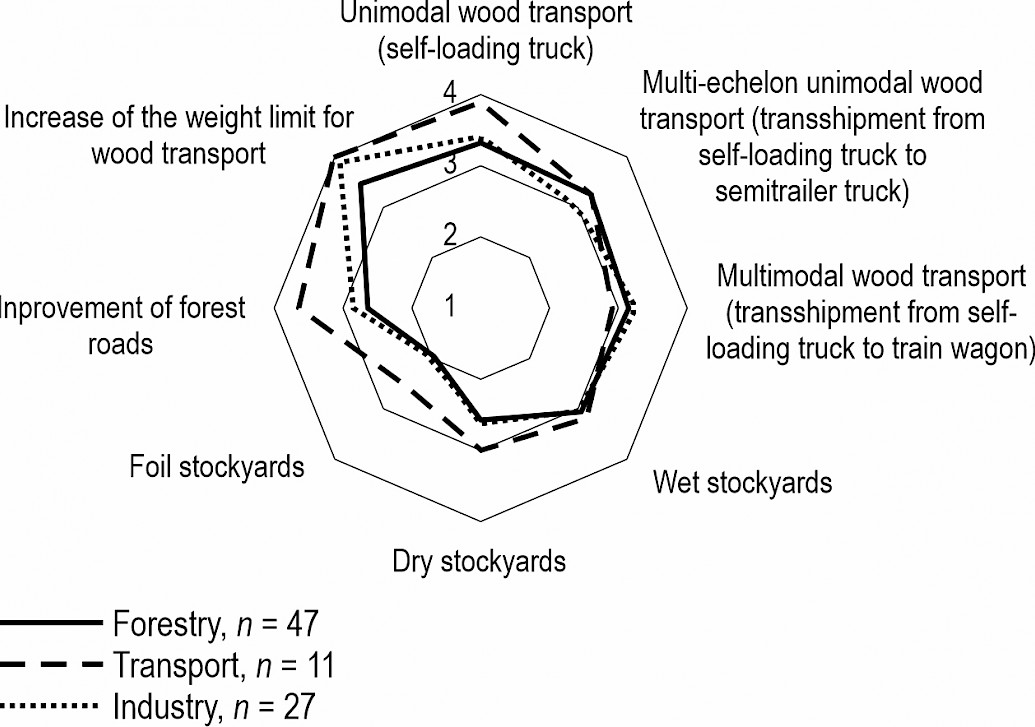
Fig. 5 Potential assessment of all actors along the wood supply chain for logistical concepts to cope with high amounts of salvage wood (4: very high, 3: rather high, 2: rather low, 1: very low)
The detailed assessment of the individual stakeholder group shows that 57% of forestry (Fig. 6), 89% of industry (Fig. 7) and 100% of transport actors (Fig. 8) rated the potential for an increase of the current weight limit (44 tons for wood transport within 100 km from harvesting area) with »very high«. Furthermore, it is striking that forestry actors assessed the potential for multi-echelon unimodal transport higher (»very high« or »rather high«: 86%) than that of unimodal transport (81%) and multimodal transport (75%). Contrarily, industry actors rated the potential for multimodal transport and unimodal transport (both 78%) higher than that of multi-echelon unimodal transport (70%). Only for transport actors, the potential for unimodal transport (100%) clearly exceeded those of multi-echelon unimodal transport (91%) and multimodal transport (82%).

Fig. 6 Assessment of potential logistical concepts for coping with high amounts of salvage wood by forestry actors
Along the wood value chain, there is a strong belief in the potential of wet stockyards evidenced by 82% »rather high« or »very high« ratings from transport actors, 76% from forestry and 74% from industry. Dry stockyards also hold future potential (»very high« or »rather high«: 72% transport, 59% industry, 49% forestry), whereas foil stockyards will play only a minor role (»rather low« or »very low«: 81% forestry, 74% industry, 45% transport.
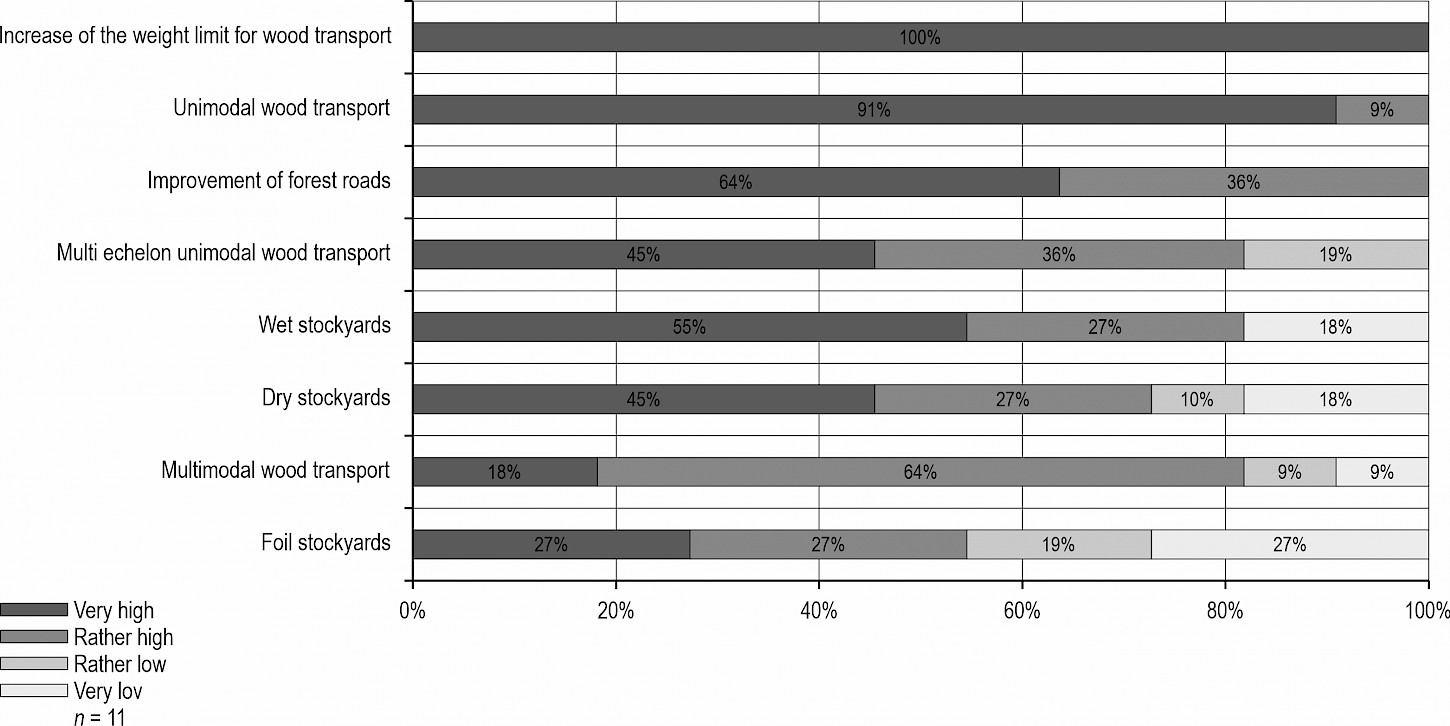
Fig. 7 Assessment of potential logistical concepts for coping with high amounts of salvage wood by industry actors
Transport actors rely exhaustively on the potential of improvements in forest roads with 100% ratings of »very high« or »rather high«. The still positive assessments of industry (63%) and forestry (47%) are much smaller. In particular, the »very high« potential, which was rated almost three times higher by transport (64%) than by industry (26%) and forestry (23%), differs greatly.

Fig. 8 Assessment of potential logistical concepts for coping with high amounts of salvage wood by transport actors
3.3 Transport
Empirical analysis revealed unimodal transport with self-loading log-truck as preferred transport mode (65%) across the entire value chain. Multi-echelon unimodal transport with a transhipment from self-loading log-trucks to semitrailer trucks is steadily increasing in popularity (16%) and already comes close to the percentage value of multimodal transport with a transhipment from self-loading log-trucks to train wagons (19%). Fig. 9 shows similar percentages for unimodal transport of large-scale forest owners, industry as well as transport actors, while small-scale forest owners use this transport mode more frequently. Compared to the other actors, industry tends to favor multi-echelon unimodal transport, whereas multimodal transport has more relevance for large-scale forest owners and transport actors.
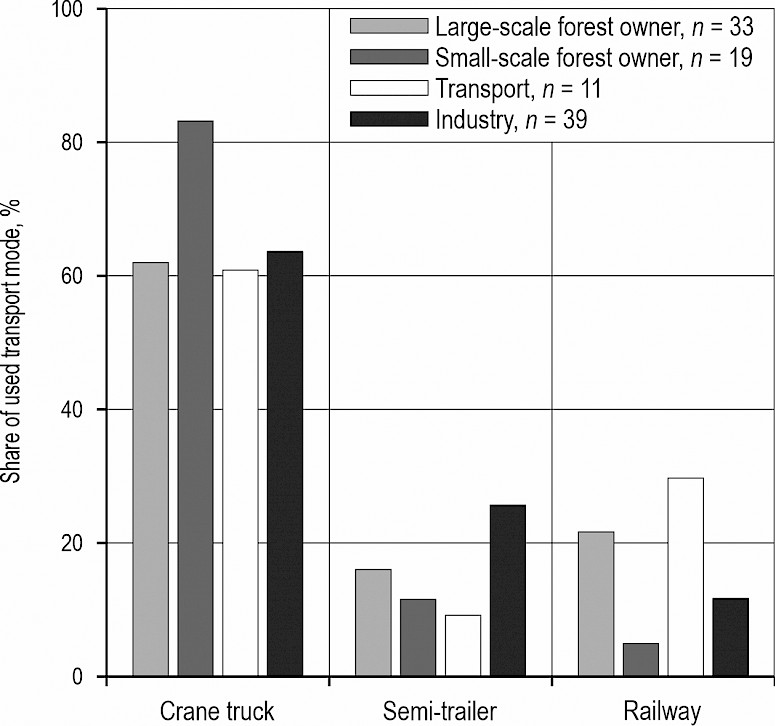
Fig. 9 Share of used transport mode shares of forestry, industry and transport actors
For three-quarters of the industry, forestry and transport actors, the nearest train terminal for wood is within a radius of 50 km. However, due to the closing of small wood terminals in Austria during the last decades, for 17% of the surveyed stakeholders the distance is more than 100 km. More than half (53%) of the actors along the wood supply chain already use the nearest train terminal for wood transport and about two-thirds (64%) indicate that they would use a train terminal more often if it was closer to their location. Fig. 10 reports the individual percentages for forestry and transport actors, highlighting the fact that even though the majority have access to a train terminal within 30 km, there are also actors who have to deal with longer distances. The average utilization of existing self-loading log-truck and semitrailer truck transport capacity in Austria (see Appendix: Fig. A1) is about four-fifths (lower quartile: 70%, higher quartile: 98%) and, after calamities, the reported average exceeds 100% (lower quartile: 80%, higher quartile: 125%).
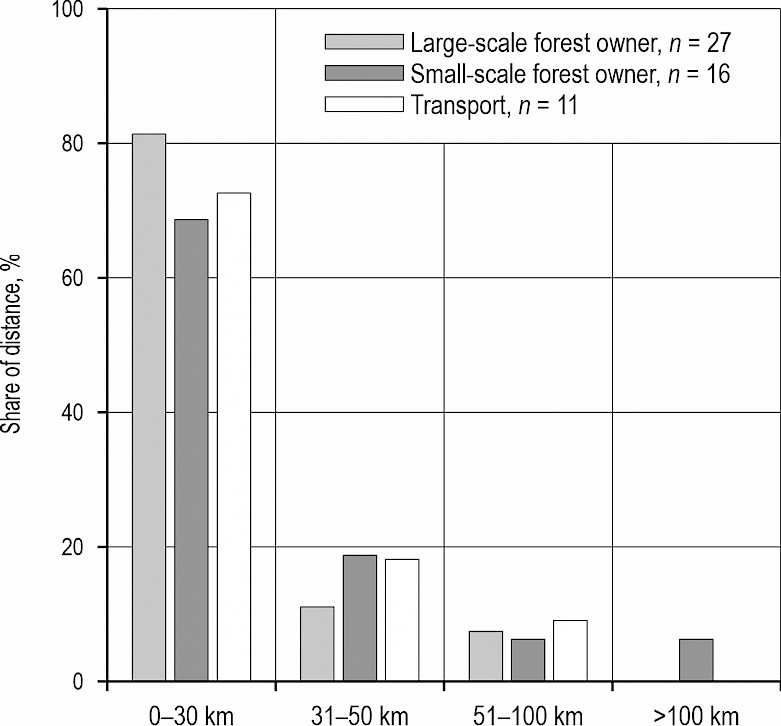
Fig. 10 Share of distances between forest and the nearest wood loading railway station
Self-loading log-trucks are the bottleneck resource in salvage wood crisis. Consequently, emerging waiting times for self-loading log-trucks are a critical factor for the transport capacity of the entire wood value chain. A Kruskal-Wallis test (α=0.05) was performed to elicit significant differences in waiting time estimates of stakeholder groups. In two cases, the null hypothesis (»estimated waiting time for self-loading log-trucks is equal for all three stakeholder groups« (H0: µ1=µ2=µ3=µ)) was rejected, which demonstrates that the estimated waiting times differ significantly for unloading at industrial sites during business as usual (0.00004<α=0.05) and in salvage wood crisis (0.0004<α=0.05) (see Fig. 11 e and f). A pairwise post-hoc test (Dunn´s test) has been conducted to further determine statistical significant differences between stakeholders in the aforementioned cases. In the business as usual scenario such difference has been calculated between the pairs forestry-industry and transport-industry. In contrast, the estimates in the salvage wood crisis scenario are statistically significant for all three pairs of stakeholders.
All stakeholder groups estimate higher waiting times during salvage wood crisis compared to the business as usual case, resulting in +160% waiting time for the transhipment to semitrailer trucks, +194% for the transhipment to train wagons, and +315% for unloading at industry. Fig. 11 shows that the self-loading log-truck waiting time varies around 20 minutes during business as usual, which indicates a good process knowledge along all actors of the wood value chain. Consequently, it is surprising that estimates about the waiting time for unloading at industry differ significantly.
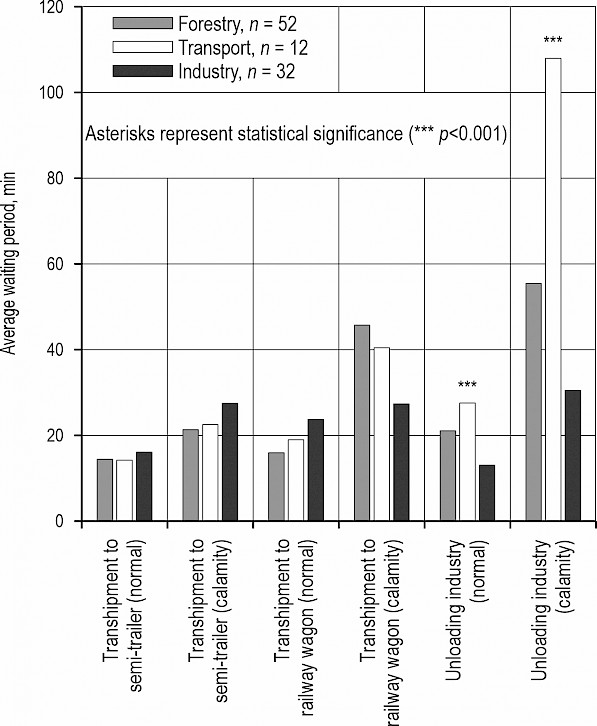
Fig. 11 Average waiting time of self-loading log-trucks during business (normal) as usual vs. salvage wood crises times (calamity)
3.4 Storage
Empirical analysis provides insights into the applied storage variants of forestry and industry for high salvage wood amounts (Table 3). Industry greatly uses stockyards at their sites (70%). Dry stockyards outside the forest is the most applied storage variant in forestry (57%) with similar importance for industry (56%). Other popular storage variants, such as wet stockyards outside the forest, dry stockyards in the forest, stockyards at train terminals and stockyards on eligible land, are operated more often by forestry (36%, 38%, 38%, 28%, respectively) than by industry (22%, 19%, 19%, 26%, respectively). Wet storages in the forest play a minor role for forestry (9%) and industry (15%). Foil stockyards were only applied in a few cases. Only a small amount of the forestry (9%) and industry (4%) actors do not use stockyards at all, which underlines the importance of storages as a coping strategy for high amounts of salvage wood.
Table 3 Storage variants for high salvage wood amounts along the wood supply chain (with an equal weighting of the two actors in the column Total)
|
Measures |
Total n = 74 |
Forestry n = 47 |
Industry n = 27 |
|
Dry stockyard outside the forest |
57% |
57% |
56% |
|
Stockyard in industrial site |
53% |
36% |
70% |
|
Wet stockyard outside the forest |
30% |
38% |
22% |
|
Dry stockyard in the forest |
28% |
38% |
19% |
|
Stockyard near railway station |
27% |
36% |
19% |
|
Stockyard on agricultural land |
27% |
28% |
26% |
|
Wet stockyard in the forest |
12% |
9% |
15% |
|
Foil stockyard outside the forest |
4% |
4% |
4% |
|
None |
6% |
9% |
4% |
|
Foil stockyard in the forest |
3% |
6% |
0% |
The detailed assessment of the individual stakeholder groups shows that 91% of forestry (Fig. 12), 88% of transport actors (Fig. 13) and 91% of industry (Fig. 14) strongly agreed or agreed that existing stockyards have good accessibility. However, a relevant proportion of forestry (27%), industry (25%) and foremost transport actors (54%) disagree or even strongly disagree that existing storage capacities are sufficient to cope with an upcoming salvage wood crisis. Consequently, 91% of transport actors, 78% of industry and 77% of forestry desire more regional wood storage options. Digitalization as well as specialized software for decision support along the wood supply chain incorporating stockyards are important contributions for 55% of forestry, 72 of transport and 70% of industry actors to cope with future salvage wood crises. In addition, the average utilization of industry storages (see Appendix: Fig. A2) reports missing storage capacity. While during business as usual around two-thirds of the stockyards are filled (lower quartile: 50%, higher quartile: 80%), the average capacity utilization rises in the case of a salvage wood crises to 98%. Similar to the utilization of self-loading log-trucks, again utilizations exceeding 100% were reported (lower quartile: 90%, higher quartile: 118%).
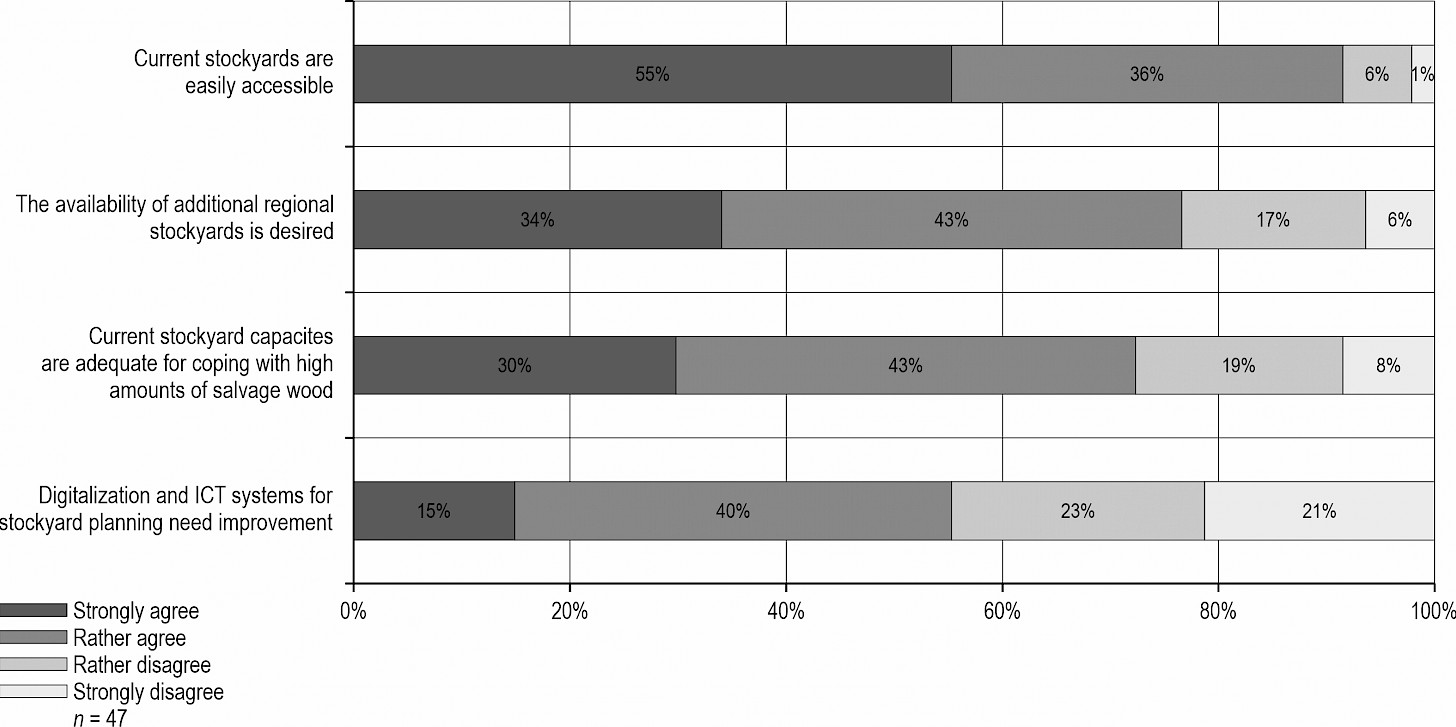
Fig. 12 Assessment of current and future storage options for coping with high amounts of salvage wood by forestry actors
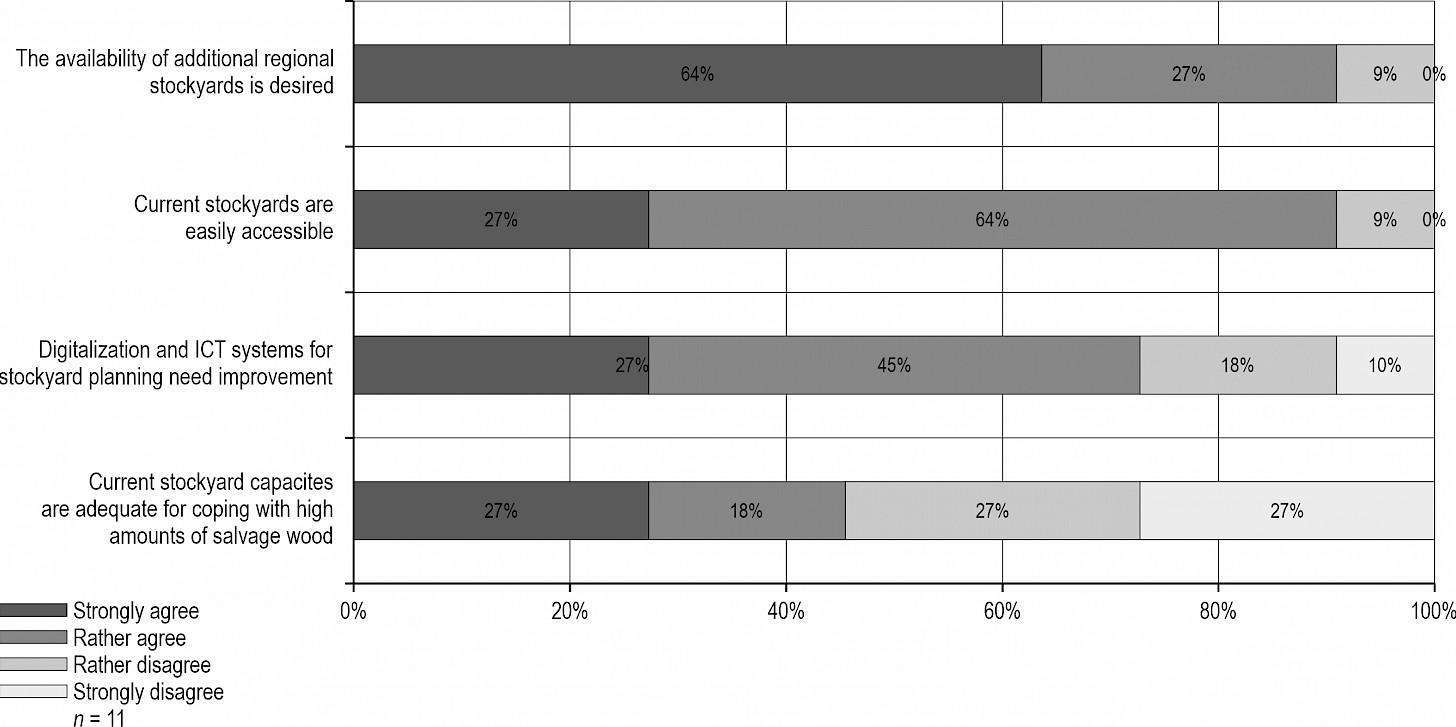
Fig. 13 Assessment of current and future storage options for coping with high amounts of salvage wood by transport actors
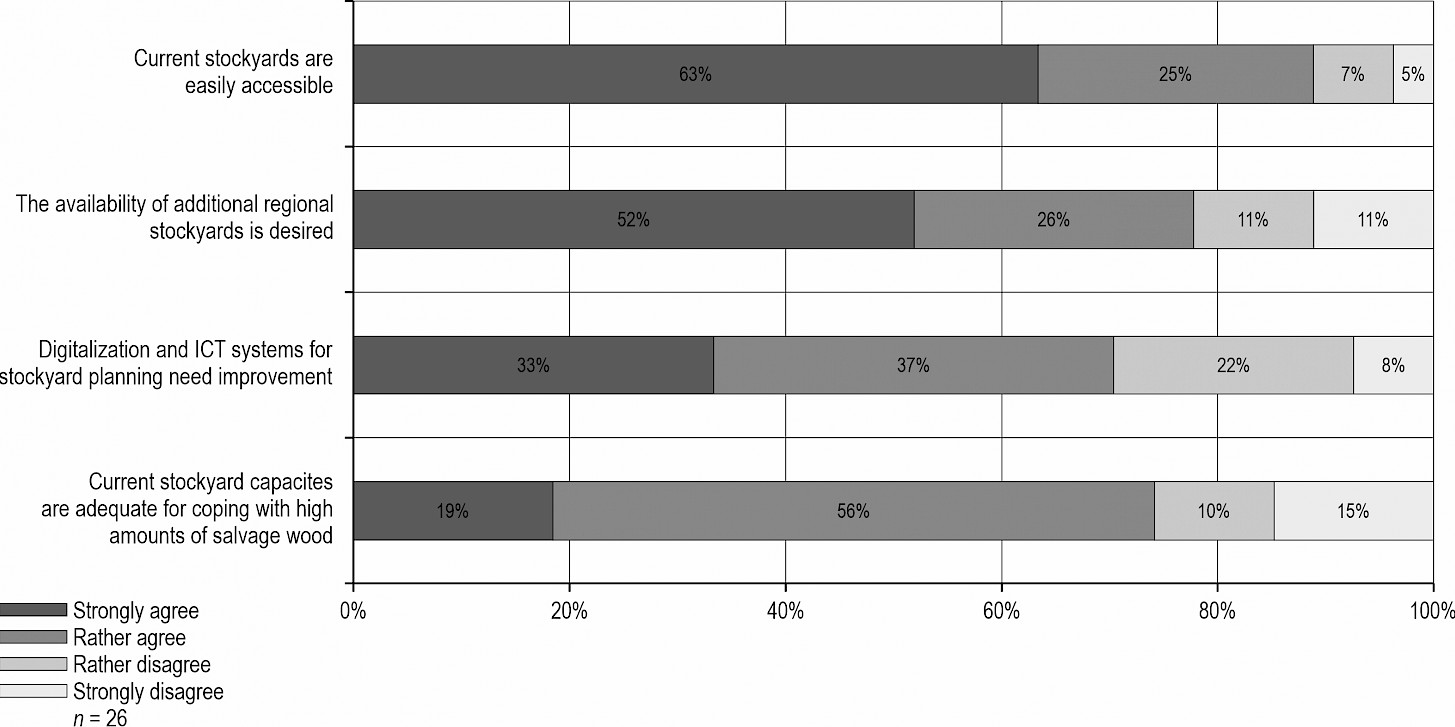
Fig. 14 Assessment of current and future storage options for coping with high amounts of salvage wood by industry actors
4. Discussion
Climate change impacts lead to more frequent and more intense forest calamities resulting, together with outdated forest management practices and a critical age structure of the forests, in an increasing amount of salvage wood. Therefore, deriving strategic, tactical, and operational measures to ensure a resilient wood supply becomes a vital task in wood supply chains all around the world. Consequently, this study observed specific issues of salvage wood logistics, focusing particularly on transport, storage and coping strategies. Wood value chains predominantly use unimodal transport concepts for log transport, which is not resilient in case of a sudden increase in demand (Kogler et al. 2020). The high truck share (self-loading log-truck and semitrailer truck 81%) with a residual share of rail transport roughly corresponds to the shares of transport modes in wood transport in Germany (Borcherding 2007).
The results regarding the transport modes and systems applied underline that small-scale forest owners and forest enterprises as well as forest carriers stick to established approaches if they have to cope a salvage wood crisis. When transporting logs, small-scale forest owners almost exclusively use self-loading log-trucks (83%), whereas large-scale forest enterprises make somewhat less use of this transport mode (62%). Semitrailer truck transport plays only a minor role for both actors, with 12% and 16%, respectively. Due to the higher average transport distances for large-scale forest enterprises, the share of rail transport accounts for 22%, whereas it is negligible for small-scale forest owners.
Also, transport actors rely on well-integrated transport concepts and, therefore, see the highest potential in self-loading log-truck transport (91% agreement), while there is less agreement on transhipping salvage wood on semitrailer (45%) or rail (18%). Both transport systems cause a considerable additional organizational effort and a more complex dispatching process for freight companies. Simultaneously, further research shows that carriers underestimate the bottleneck of self-loading log-truck transport capacity and its consequences during forest calamities, such as wood quality losses due to blue stain or beetle infestation (Kogler and Rauch 2023). The preferred use of self-loading log-trucks by forestry and transport actors is based on economic aspects in addition to operational habit, as transport costs are the essential criterion for both actors when choosing the mode of transport, whereas risk management considerations and contingency planning are underdeveloped. If high amounts of salvage wood need to be transported quickly out of the forest, the reported transport capacity utilization exceeds 100% indicating the deployment of short-term coping strategies such as overtime hours (e.g., Saturday shifts) of existing staff, temporary employment of additional drivers (e.g., retired drivers, former employees, family members), temporary hiring of transport actors from regions outside the salvage wood region as well as temporary rental of external semitrailer trucks.
Due to the large procurement area of sawmills as well as pulp and paper industry, they regularly tranship logs to semitrailers or train wagons for longer transport distances of several hundred kilometres. In the case of semitrailer truck transport, wood imports are partly responsible for the high maximum value of on average 188 km. In contrast to the rest of the wood value chain actors, industry actors consider wood transport from the forest by truck followed by rail transport as the most promising transport concept. Thus, industry rates multimodal transport concepts, in particular the combination of truck and rail, as a viable option for coping with salvage wood crises. In the case of a salvage wood crisis, increasing rail transport cuts supply peaks, significantly reduces unloading times at industry terminals and provides additional buffer due to the log storage capacities at train terminals. However, many forestry operations and freight companies continue to rely exclusively on direct self-loading log-truck transport even though the already existing shortage of drivers who can handle a crane is likely to worsen in the future (e.g., for Finland – Palander et al. 2012 and Malinen et al. 2014; for Germany – Freise et al. 2015, Borchert et al. 2019 and Becker 2019; for the USA – Costello and Karickhoff 2019 and Conrad 2018). Without recourse to rail transport, this bottleneck can only be overcome by increasing utilization of semitrailer truck transport because significantly fewer self-loading log-truck drivers are needed in a combined system of semitrailer trucks and self-loading log-trucks (Kogler et al. 2020).
The main obstacle to transport wood by rail is the lack of train terminals in the countryside as a result of the pressure for cost reduction causing the closure of unprofitable, hardly used loading stations. Furthermore, the poor performance of rail companies in terms of both flexibility and adherence to schedules, lack of availability of wagons as well as the lack of storage capacity at loading stations hinders the switch to train transport to cope with non-regular situations. However, there are also practical reasons for preferring other modes of transport. About half of forestry operations surveyed do not use a wood loading station because rail transport is unprofitable due to short transport distances and the fact that some customers can only be supplied by self-loading log-trucks or semitrailer trucks due to their lack of a rail siding.
Queuing times for transhipment to a semitrailer truck or train wagon as well as unloading at the industrial site are consistently estimated by the various stakeholders to be higher in case of a calamity than under regular circumstances. The waiting time estimates provided by industry actors for trucks when unloading at the industrial site in the regular case are similar to those of other studies (Kretzer et al. 2009). Nevertheless, there are statistically significant differences in estimates among the three stakeholder groups for waiting times at the industry site. Wood supply managers from sawmills as well as pulp and paper industry report waiting time for unloading at industrial facilities in the event of calamity as only 30 minutes on average, contrary to forestry and freight companies who report 55 and 107 minutes, respectively. While all stakeholder groups attest to longer waiting times in the event of a calamity, different perceptions, or at least official statements on the absolute extent of time delays, are possibly clouded by self-interest or may be a measure used to strengthen one's own position in freight tariff negotiations. In the event of a salvage wood crisis, a high industry storage capacity utilization (98% on average) leads to rapidly increasing unloading times as a result of higher pile heights and longer travel distances at the log yard. Since waiting times are included in the freight rates negotiated between transport actors and industry or, less frequently, the forestry actors, there is a pressure for carriers to renegotiate freight rates or for additional compensation. According to estimates by German freight companies, waiting times reduce the amount of wood transported by 11% (Gößwein et al. 2019). Corresponding values for the Austrian wood supply chain were calculated based on the reported values in this study for eight-hour shifts of daily working time and an average of two log deliveries per day. The waiting time induced lost transport capacity for semitrailer truck transport, train transport and unimodal truck transport during periods of business as usual is 6%, 8% and 9%, respectively, and rises during salvage wood crises to 10%, 16% and 27%.
It was also found that transport capacity could be better exploited if delays at mills were decreased (Borchert et al. 2019). Stakeholders see deficiencies in the organization of log transport, bottlenecks in unloading capacity and lack of time management as main reasons for long delays in log handling. Together with freight companies, forestry actors demand better coordination with industry and propose a supply system with fixed time slots for wood removal in the forest as well as for unloading at the industrial sites. Industry sees digital tracking of trucks (i.e., fleet management) as a way to ensure better supply management and reduce waiting times.
In the event of a salvage wood crisis, wood supply chain actors largely resort to a few field-tested measures. Industry readily extends receiving hours at the log yard, a measure rated as most important by more than half of the wood supply managers, which is well-appreciated by transport actors in order to buffer the high utilization or partial overloading of transport capacity associated with a forest calamity event. In fact, in salvage wood crises, industry reports stockyard utilizations exceeding 100%, indicating the deployment of short-term coping strategies, such as renting additional but not permanently existing storage capacities, building new temporal stockyards while wagering that the lengthy approval process of public authorities to permit the wood storage at the given location serve their situational necessity, or overfilling existing storages with the drawback of inefficient handling times due to space limitations or dangerously high wood piles.
In addition, the most frequent short-term measures in industry include training of personnel to provide manpower for the increased working hours. In the medium and long term, additional storage areas are constructed for wet storage and intensification of cooperation with forestry actors, respectively. A measure that is also regarded by the forest enterprises as the most important step in coping with a calamity is the long-term cooperation with freight companies and the construction of additional storage areas for dry storage. Accordingly, wet storage of salvage wood as a measure to be taken draws the most interest by German forest enterprises and the German saw milling industry (AGR and DESH 2020). Cost saving potential of intensified cooperation in an integrated supply chain setting was calculated for an Austrian case study with a mixed integer programming model resulting in up to 24% savings, which can be reinforced by higher truck payloads up to 40% (Kogler et al. 2021).
Guarantee of a prompt absorption of salvage wood by the industry as well as securing necessary freight capacity are priorities for forestry actors. Salvage wood should be transported quickly and with as little loss of quality as possible from the forest directly to industry and only surplus quantities are stored temporarily in a dry storage facility for the short term or in a wet storage facility outside the forest for the medium term, primarily for forest protection reasons. For transport actors, response of industry, which mostly orders and pays for log transport, to a forest calamity event is most decisive. In order to increase planning security, especially with regard to an increase in their own truck fleet, transport actors rely on long-term contracts and intensive cooperation with the industry. As wood is also increasingly transhipped to trains, many carriers also recognize training of their own personnel as very important. This is so that the very strict railroad regulations regarding loading safety can be complied with as adjusting waggons not loaded according to the rules hinders transportation and generates extra costs.
Construction of new log yards, especially wet stockyards outside the forest, increases storage capacity and provides a buffer in the event of high volumes of salvage wood to ensure a continuous flow of wood with moderate waiting times and also to cut supply peaks. Forestry actors and industry currently use mainly dry storage outside the forest and industrial storage for storing salvage wood. The third most frequently used concept is wet storage outside the forest, thus, about one-third of each of the surveyed forestry enterprises and industry have established wet storage following a salvage wood crisis. It can be assumed that these values will continue to rise in the future, as wet storage was rated by both stakeholder groups as the most promising storage concept by far. In contrast, foil storage has only a very low actual relevance for both actors and very little potential has been attributed to this concept. This is probably due to the limited size of the piles and the high technical effort required to implement such storage facilities.
Almost unanimous support for an increase in the legally permitted transport tonnage by industry and transport companies, 89% and 100% respectively, contrasts with support by the forestry stakeholders with only 57%. Here, forestry actors are concerned with the higher strain put on forest infrastructure, possibly inducing higher maintenance costs. Increasing transport capacity speeds up the removal of salvage wood while at the same time reducing CO2 emissions (Klvac et al. 2013), reduces the number of trips required between forest and industry by bundling transport orders (Gronalt et al. 2005) and the number of trucks required (Kogler et al. 2020). Higher legal gross vehicle weight also results in lower trucking costs (Borcherding 2007) and lower fuel consumption per m3 of wood transported (Väätäinen et al. 2020). As expected, improvement of the forest road network is of particular interest to transporters, while there is less agreement among industry and forest enterprises in this respect. However, as transport actors have the most experience on the actual condition of forest roads, their expectations and concerns should be taken more seriously. Only a few companies in the Austrian value chain have prepared contingency plans in advance to cope with salvage wood.
Limitations of the conducted study are principally in the restrictions of area and time. Building on the reported results, further empirical studies of specific topics such as condition of road surface or bearing capacity (cf. Malinen et al. 2014), too low freight prices (cf. Borcherding 2007) and high fuel prices, both seen as major future risks by carriers (Freise et al. 2015), provide further insights into wood transportation problems. However, in comparison with similar empirical studies, a larger sample size and more questions were included and a comprehensive, well-balanced, representative ratio of actors were incorporated.
Further relevant topics connected to the presented analyses include the important role of geographical information systems for transport modelling with geospatial data, disaggregated models and geo-visualization (Scholz et al. 2008, Atzl et al. 2019, Scholz et al. 2021) as well as geospatial artificial intelligence (Dopler and Scholz 2021). Loidl et al. (2016) formulated a useful guideline for the future development of forest-based supply chains regarding a seamless information flow, integrated management as well as facilitating data exchange and collaboration. To ensure that technological developments can be implemented along traditional wood value chains and their conservative actors, organizational measures must be taken to ensure internal system readiness. To this end, it is expedient to accompany the technology-related new processes with change management and process reengineering in order to establish the necessary organizational culture change (e.g., readiness for innovation through data-based decision support) and structural trust building (e.g., readiness to cooperate for transparent data exchange) broadly along the wood value chain.
5. Conclusions
The analysis of findings of the empirical study regarding logistical systems, transport modes and distances as well as storage concepts between regular wood supply and a salvage wood crisis enabled the formulation of coping strategies. Accordingly, salvage wood must be removed from the forest as quickly as possible and transported directly to industry as a matter of priority. Only surplus volumes should be placed in intermediate stockyards outside the forest. To achieve this, additional transport capacity must be secured by proactively recruiting wood carriers from regions not affected by the salvage wood event and by making full use of Saturday shifts and longer working hours for drivers within legal limits.
Due to recurring forest calamities, the increase of storage capacities is an important instrument to implement buffer facilities along the supply chain. In this respect, the entire wood value chain considers in particular the expansion of regional storage sites, preferably outside the forest, to be a suitable coping strategy. Dry storage facilities, especially for industrial wood, are seen as an extremely important concept for coping with salvage wood crises, as they serve both as a buffer in the case of a lack of supply options and to secure supply when forest roads are not passable by truck (e.g., snow, rain). However, usually the sole use of unimodal truck transport quickly reaches its limits, especially driven by a lack of both self-loading log-trucks as well as specialized drivers. Therefore, salvage wood should also be transhipped immediately to train wagons enabling to transport high amounts of wood out of the crisis regions in order to achieve a higher price elsewhere also compensating the higher transport costs. However, the empirical study showed that due to the decreasing number of loading stations there are ever longer supply distances and that wagon provision is unreliable. In the case of salvage wood, self-loading log-truck drivers often load wagons for the first time, frequently violating the loading guidelines, which subsequently leads to wagons being restricted from further transport by railroad security personnel. If rail transport is not possible due to a lack of wagons or economical unviability caused by long distances to the next train terminal for wood, multi-echelon unimodal wood transport with semitrailers is an appropriate alternative. According to all actors' experiences, truck drivers for semitrailers are more readily available than self-loading log-truck drivers as the latter need both crane handling capabilities and specific forest knowledge.
In addition to missing self-loading log truck drivers, the takeover capacity at industry stockyards is often the next bottleneck, particularly when approaching the capacity limit of the log yard results in very long waiting times. Introduction of longer service times in the mills (especially on Saturdays) as well as an increase of the tonnage limit for log-truck transport were unanimously named as suggestions for urgent improvement in the logistics of salvage wood. Furthermore, it was found that risk management concepts, coping strategies or standardized contingency planning for recurring risks are missing in the sector as well as on the company level. In addition, experiences regarding strategies and procedures of past forest calamity events are not documented, therefore prohibiting learning processes of actual staff based on professional knowledge management.
Each sector of the wood supply chain evaluates the difficulties and challenges specific to their own domain as the most important, which reflects a pronounced competitive thinking and a lack of cooperative consensus in the case of a salvage wood crisis. Contrarily, deepening cooperation to better cope with salvage wood calamities has been evaluated as a major step for improvement by all actors. Therefore, specifying the consensus of cooperation in terms of operational measures and previous as well as future steps to build mutual trust need to be investigated in detail.
Acknowledgments
This research was funded within the SKAT project by the Austrian Federal Ministry of Agriculture, Forestry, Regions and Water Management.
Appendix

Fig. A1 Average transport capacity utilization of transport actors

Fig. A2 Average storage utilization of industry actors
6. References
AFRW Austrian Federal Ministry of Agriculture, Forestry, Regions and Water Management, 2023: Austrian Wood Report. Available online: https://info.bml.gv.at/dam/jcr:a5c90b98-5c24-4bd6-a9f1-60cbbda8cfff/BML_broschuere_oesterreichischer_waldbericht2023_200dpi_pac3.pdf (accessed on 10 March 2024)
AFRW Austrian Federal Ministry of Agriculture, Forestry, Regions and Water Management, 1990–2022: Forest Reports 1990–1996, Green Reports 1997–1999, Wood Harvest Reports 2000–2022. Available online: https://info.bmlrt.gv.at/themen/wald/wald-in-oesterreich/wald-und-zahlen/Holzeinschlag.html and https://www.verwaltung.steiermark.at/cms/ziel/74835646/DE (accessed on 10 March 2024)
Acuna, M., 2017: Timber and biomass transport optimization: a review of planning issues, solution techniques and decision support tools. Croatian Journal of Forest Engineering 38(2): 279–290.
Acuna, M., Sessions, J., Zamora, R., Boston, K., Brown, M., Ghaffariyan, M.R., 2019: Methods to manage and optimize forest biomass supply chains: A review. Current Forestry Reports 5: 124–141. https://doi.org/10.1007/s40725-019-00093-4
AGR Arbeitsgemeinschaft Rohholz e.V. and DeSH Bundesverband der Deutschen Säge- und Holzindustrie e.V., 2020: Survey on regional storage of salvage wood.
Atzl, C., Scholz, J., Vockner, B., Mittlböck, M., Knoth, L., 2019: Role-tailored map dashboards – a new approach for enhancing the forest-based supply chain. ISPRS International Journal of Geo-Information 8(1): 1–29. https://doi.org/10.3390/ijgi8010041
Becker, F., 2019: Wood transport companies – The eye of the needle between forest and mill. Thesis, University of Applied Sciences Erfurt, 83 p.
Borcherding, M., 2007: Roundwood transport logistics in Germany – a transaction cost oriented empirical analysis. Dissertation, University Hamburg.
Borchert, H., Gößwein, S., Schusser, M., 2019: How to deal with an upcoming shortage of wood transporting capacity in Germany? Conference proceedings FORMEC »Exceeding the Vision: Forest Mechanisation of the Future« 6–9 October, Sopron, Hungary, 151–160.
Conrad, J., 2018: Costs and challenges of log truck transportation in Georgia, USA. Forests 9(10): 650. https://doi.org/10.3390/f9100650
Costello, B., Karickhoff, A., 2019: Truck driver shortage analysis 2019. American trucking association, 16 p. Available online: https://www.trucking.org/sites/default/files/2020-01/ATAs%20Driver%20Shortage%20Report%202019%20with%20cover.pdf (accessed on 10 March 2024)
D'Amours, S., Rönnqvist, M., Weintraub, A., 2008: Using operational research for supply chain planning in the forest products industry. INFOR Information Systems and Operational Research 46(4): 265–281. https://doi.org/10.3138/infor.46.4.265
Dopler, S., Scholz, J., 2021: A prototypical geospatial knowledge graph and spatio-temporal question answering for supply chain visibility. In Short Paper Proceedings of the Spatial Data Science Symposium 2021: 1–7. https://doi.org/10.25436/E2JS3V
Ebner, G., 2020: Substantially more damaged wood in 2019, Holzkurier. Online available: https://www.holzkurier.com/rundholz/2020/02/2019-deutlich-mehr-schadholz.html (accessed on 10 March 2024)
Eurostat, 2020: Agriculture, forestry and fishery statistics. https://doi.org/10.2785/496803
FAO Food and Agriculture Organization of the United Nations, 2018: The state of the world's forests 2018 – Forest pathways to sustainable development. https://doi.org/10.18356/18a7cf8d-en
FAO Food and Agriculture Organization of the United Nations, 2020: The state of the world's forests 2020 – Forests, biodiversity and people. https://doi.org/10.4060/ca8642en
FAO Food and Agriculture Organization of the United Nations, 2022: The state of the world's forests 2022 – Forest pathways for green recovery and building inclusive, resilient and sustainable economies. https://doi.org/10.4060/cb9360en
Freise, L., Ohnesorge, D., Prawdzik, P., Kopetzky, M., Degen, J., 2015: Optimization of wood transport in Baden-Wuerttemberg, 37 p. Available online: http://media.repro-mayr.de/50/648150.pdf (accessed on 10 March 2024)
Gößwein, S., Schusser, M., Borchert, H., 2019: Market study round wood logistics in Bavaria, 83 p. Available online: https://www.lwf.bayern.de/service/publikationen/sonstiges/218694/index.php (accessed on 10 March 2024)
Gronalt, M., Chloupek, A., Greigeritsch, T., Häuslmayer, H., 2005: WoodLog – optimization potentials by a wood logistics control center Austria, 144 p. https://boku.ac.at/map/holztechnologie/schriftenreihe-lignovisionen-alt/band-issue-11
Hedeler, B., Lettner, M., Stern, T., Schwarzbauer, P., Hesser, F., 2020: Strategic decisions on knowledge development and diffusion at pilot and demonstration projects: An empirical mapping of actors, projects and strategies in the case of circular forest bioeconomy. Forest Policy and Economics 110: 1–8. https://doi.org/10.1016/j.forpol.2019.102027
Hirsch, P., Gronalt, M., 2013: The timber transport order smoothing problem as part of the three-stage planning approach for round timber transport. Journal of Applied Operational Research 5(2): 70–81.
Hynynen, J., Salminen, H., Ahtikoski, A., Huuskonen, S., Ojansuu, R., Siipilehto, J., Lehtonen, M., Eerikäinen, K., 2015: Long-term impacts of forest management on biomass supply and forest resource development: a scenario analysis for Finland. European Journal of Forest Research 134: 415–431. https://doi.org/10.1007/s10342-014-0860-0
Klvac, R., Kolaik, J., Volna, M., Drapela, K., 2013: Fuel consumption in timber haulage. Croatian Journal of Forest Engineering 34(2): 229–240.
Kogler, C., 2016: Optimization of timber–flow logistics at the Papierholz Austria GmbH. Thesis, University of Graz. https://doi.org/10.13140/RG.2.2.32046.51528/1
Kogler, C., 2020: Decision support by discrete event simulation for the wood supply chain. Dissertation, University of Natural Resources and Life Sciences, Vienna. Available online: https://permalink.obvsg.at/bok/AC16139733 (accessed on 10 March 2024)
Kogler, C., Rauch, P., 2018: Discrete event simulation of multimodal and unimodal transportation in the wood supply chain: a literature review. Silva Fennica 52(4): 1–29. https://doi.org/10.14214/sf.9984
Kogler, C., Rauch, P., 2019: A discrete event simulation model to test multimodal strategies for a greener and more resilient wood supply. Canadian Journal of Forest Research 49(10): 1298–1310. https://doi.org/10.1139/cjfr-2018-0542
Kogler, C., Rauch, P., 2020a: Contingency plans for the wood supply chain based on bottleneck and queuing time analyses of a discrete event simulation. Forests 11(4): 396. https://doi.org/10.3390/f11040396
Kogler, C., Rauch, P., 2020b: Game-based workshops for the wood supply chain facilitate knowledge transfer. International Journal of Simulation Modelling 19(3): 446–457. https://doi.org/10.2507/IJSIMM19-3-526
Kogler, C., Schimpfhuber, S., Eichberger, C., Rauch, P., 2021: Benchmarking procurement cost saving strategies for wood supply chains. Forests 12(8): 1086. https://doi.org/10.3390/f12081086
Kogler, C., Stenitzer, A., Rauch, P., 2020: Simulating combined self-loading truck and semitrailer truck transport in the wood supply chain. Forests 11(12): 1245. https://doi.org/10.3390/f11121245
Kogler, C., Rauch, P., 2023: Lead time and quality driven transport strategies for the wood supply chain. Research in Transportation Business & Management 47: 1–13. https://doi.org/10.1016/j.rtbm.2023.100946
Kogler, C., 2023: Discrete event simulation-based risk analysis for efficient, sustainable and resilient transportation. Soudni Inzenyrstvi 34(1): 74–78. doi.org/10.13164/SI.2023.1.74
Kretzer, J., Becker, W., Zollner, H., Kulterer, S., Holzleitner, F., Stampfer, K., Hochsteiner, A., Hochsteiner, W., Gasser, C., Bachmann, M., 2009: Supply chain forestry, logistics, sawmills. Project report, 61 p. Available online: https://nachhaltigwirtschaften.at/de/fdz/projekte/supply-chain-forst-logistik-saege-als-erstanwendungsplattform-von-it-telematikkonzepten-zur-ressourceneffizienten-holznutzung-im-gebirgswald.php (accessed on 10 March 2024)
Loidl, M., Wallentin, G., Cyganski, R., Graser, A., Scholz, J., Haslauer, E., 2016: GIS and transport modeling – strengthening the spatial perspective. ISPRS International Journal of Geo-Information 5(6): 1–23. https://doi.org/10.3390/ijgi5060084
Malinen, J., Nousiainen, V., Palojärvi, K., Palander, T., 2014: Prospects and challenges of timber trucking in a changing operational environment in Finland. Croatian Journal of Forest Engineering 35(1): 91–100.
Palander, T., Vainikka, M., Yletyinen, A., 2012: Potential mechanisms for cooperation between transportation entrepreneurs and customers: A case study of regional entrepreneurship in Finland. Croatian Journal of Forest Engineering 33(1): 89–103.
Rauch, P., 2007: SWOT analyses and SWOT strategy formulation for forest owner cooperations in Austria. European Journal of Forest Research 126: 413–420. https://doi.org/10.1007/s10342-006-0162-2
Rauch, P., Wolfsmayr, U.J., Borz, S.A., Triplat, M., Krajnc, N., Kolck, M., Oberwimmer, R., Ketikidis, C., Vasiljevic, A., Stauder, M., Mühlberg, C., Derczeni, R., Oravec, M., Krissakova, I., Handlos, M., 2015: SWOT analysis and strategy development for forest fuel supply chains in South East Europe. Forest Policy and Economics 61: 87–94. https://doi.org/10.1016/j.forpol.2015.09.003
Scholz, J., Breitwieser, F., Mandl, P., 2021: Simulating the forest fuel market as a socio‐ecological system with spatial agent‐based methods – a case study in Carinthia, Austria. Natural Resource Modeling 34(1): 1–54. https://doi.org/10.1111/nrm.12291
Scholz, J., Bartelme, N., Prüller, R., Strauss, C., 2008: Optimizing the wood supply chain – concept and methods. International Journal of Spatial Data Infrastructures Research 3(3): 95–117. https://doi.org/10.2902/1725-0463.2008.03.art7
Väätäinen, K., Anttila, P., Eliasson, L., Enström, J., Laitila, J., Prinz, R., Routa, J., 2020: Roundwood and biomass logistics in Finland and Sweden. Croatian Journal of Forest Engineering 42(1): 39–61. https://doi.org/10.5552/crojfe.2021.803
© 2023 by the authors. Submitted for possible open access publication under the
terms and conditions of the Creative Commons Attribution (CC BY) license (http://creativecommons.org/licenses/by/4.0/).
Authors' addresses:
Christoph Kogler, PhD *
e-mail: christoph.kogler@boku.ac.at
Alexander Beiglböck, BSc
e-mail: alexander.beiglboeck@ boku.ac.at
Prof. Peter Rauch, PhD
e-mail: peter.rauch@boku.ac.at
University of Natural Resources and Life Sciences, Vienna
Gregor-Mendel-Straße 33
1180 Vienna
AUSTRIA
* Corresponding author
Received: January 12, 2023
Accepted: October 25, 2023
Original scientific paper

